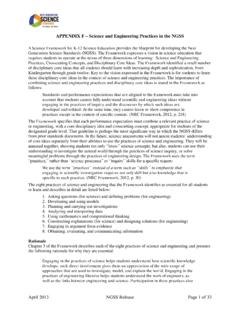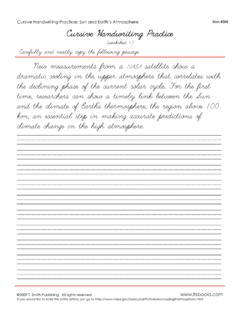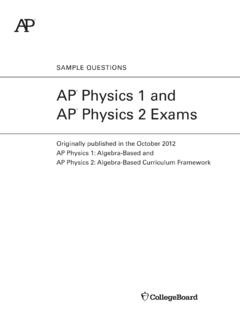Transcription of A Good Practice Guide to the Administration of Substances ...
1 JOURNAL OF APPLIED TOXICOLOGYJ. Appl. , 15 23 (2001)A Good Practice Guide to the Administrationof Substances and Removal of Blood,Including Routes and VolumesKarl-Heinz Diehl1, Robin Hull2, David Morton3, Rudolf Pfister4, Yvon Rabemampianina5,David Smith6,*, Jean-Marc Vidal7and Cor van de Vorstenbosch81 Aventis, PO Box 1140, D35001 Marburg, Germany2N I B S C, Blanch Lane, South Miimms, Potters Bar, Hertfordshire EN6 3QG3 The University of Birmingham, Medical School, Edgbaston, Birmingham B15 2TT4 Novartis Pharma AG, CH-4002 Basel, Switzerland5 Centre de Recherche Pfizer, Etablissement d Amboise, Z1 Poce -sur-Cisse-BP 159 37401 Amboise Cedex, France6 AstraZeneca R&D Charnwood, Bakewell Road, Loughborough, Leics LE11 5RH7 Aventis, 102 Route de Noisy.
2 95235 Romainville Ce dex, France8N V Organon, PO Box 20, 5340 BH Oss, NetherlandsKey words: blood volumes; blood removal; Administration Substances ; laboratory animals; article is the result of an initiative between the European Federation of Pharmaceutical IndustriesAssociations (EFPIA) and the European Centre for the Validation of Alternative Methods (ECVAM).Its objectives are to provide the researcher in the safety evaluation laboratory with an up-to-date, easy-to-use set of data sheets to aid in the study design process whilst at the same time affording maximumwelfare considerations to the experimental this article is targeted at researchers in the European Pharmaceutical Industry, it isconsidered that the principles underpinning the data sets and refinement proposals are equally applicableto all those who use these techniques on animals in their research, whether in research institutes,universities or other sectors of industry.
3 The implications of this article may lead to discussion withregulators, such as those responsible for pharmacopoeial are numerous publications dealing with the Administration of test Substances and the removalof blood samples, and many laboratories also have their own in-house guidelines that have beendeveloped by custom and Practice over many years. Within European Union Directive 86/609 EEC1wehave an obligation to refine experiments to cause the minimum amount of stress. We hope that thisarticle will provide background data useful to those responsible for protocol design and Guide is based on peer-reviewed publications whenever possible, but where this is not possiblewe have used in-house data and the experience of those on the working party (as well as helpfulcomments submitted by the industry) for a final opinion.
4 The Guide also addresses the continuing needto refine the techniques associated with the Administration of Substances and the withdrawal of blood,and suggests ways of doing so. Data-sharing between laboratories should be encouraged to avoidduplication of animal work, as well as sharing practical skills concerning animal welfare and scientificproblems caused by overdosing in some way or another. The recommendations in this Guide refer tothe normal animal, and special consideration is needed, for instance, during pregnancy and of studies may be confounded when large volumes are administered or excessive samplingemployed, particularly if anaesthetics are used. Copyright 2001 John Wiley & Sons, Practice Guide FORADMINISTRATION OF SUBSTANCESI ntroductionDosing of experimental animals is necessary for avariety of scientific investigations and to meet regulat-* Correspondence to: Dr David Smith, Senior Director, Toxi-cology, AstraZeneca, R&D Charnwood, Bakewell Road, Lough-borough LE11 5 RHReceived 6 February 2000 Copyright 2001 John Wiley & Sons, 27 September 2000ory demands.
5 The pharmaceutical industry, in parti-cular, has investigated the levels of dosing compatiblewith animal welfare and valid the preclini-cal stage of the safety evaluation of new drugs it isnormal Practice to use multiples of the effective dose in order to attempt to establish the necessary safetymargins. Where chemicals are of low toxicity or areonly poorly soluble in acceptable formulations, a largevolume may be required to be given to individualanimals to satisfy both scientific and regulatory require-ments. The intended clinical use may also have animpact on the acceptability of larger than usual dosevolumes, imaging agents or plasma expanders forintravenous DIEHLET objectives of the Technical Sub group of EFPIA/ECVAM were as follows:(i)to provide a Guide on Administration volumes foruse in common laboratory species used in toxicitystudies required by regulatory authorities;(ii)to provide consensus dosage levels for routineuse that represent good Practice in terms of ani-mal welfare and practicality.
6 (iii) to produce a Guide to dosage levels representingthe upper limit of common Practice , which leavesscope to make the case for special volumesTable 1 presents Administration volumes for the com-monly employed routes in the most frequently usedspecies. They are consensus figures based on publishedliterature and internal guidelines. The marmoset andminipig are now considered within this categorybecause they are being used increasingly in sets of values are shown in each column:values on the left are intended as a Guide to goodpractice dose volumes for single or multiple dosing;values on the right, where given, are the possiblemaximal values. If maximal values are exceeded, ani-mal welfare or scientific implications may result andreference to the responsible veterinary surgeon shouldbe made.
7 In some instances values are there to accom-modate pharmacopoeial of these suggested maximum values have beenobtained from recent literature,3,4but appear high whencompared with good Practice values. The need forcareful attention to animal welfare and the formulationof material used at high dose volumes are emphasized,particularly if repeat dosing is intended. Study durationcould be restricted and scientific validity compromisedby physiological reaction to high dose volumes. It istherefore essential from an ethical standpoint that theseissues are fully considered, by inspectorate orethical committee, before protocols are finalized andwork commences. It is also strongly recommended forethical as well as scientific reasons that physico-chemical compatibility studies (in vitro) and small-scale pilot studies (small groups of animals) are carriedout on any new formulation before committing to largerTable 1.
8 Administration volumes considered good Practice (and possible maximal dose volumes)aSpeciesRoute and volumes (ml kg 1) (bolus) (slow inj.)Mouse10 (50)10 (40)20 (80) ( )b5(25)Rat10 (40)5 (10)10 (20) ( )b5(20)Rabbit10 (15)1 (2)5 (20) ( )2(10)Dog5 (15)1 (2)1 (20) ( ) (5)Macaque5 (15)2 (5)c(10) ( )2cMarmoset10 (15)2 (5)c(20) ( ) (10)Minipig10 (15)1 (2)1 (20) ( ) (5)aFor non-aqueous injectates, consideration must be given to time of absorption before re-dosing. No more than two intramuscularsites should be used per day. Subcutaneous sites should be limited to two or three sites per day. The subcutaneous site doesnotinclude Freund s adjuvant in millilitres per not 2001 John Wiley & Sons, Appl. , 15 23 (2001)scale studies.
9 Dose volumes should be the minimumcompatible with compound formulation and accuracyof routesOral occasions, it may be necessary torestrict the animals food intake before dosing. Thisfactor may affect absorption. Large dose volumes(40 ml kg 1) have been shown to overload the stomachcapacity and pass immediately into the small volumes may also reflux into the duration of fasting will depend upon the feedingpattern of the species, the starting time for food restric-tion, the physiology of the species, the length of timeof dosing, diet and the light is recommendedthat for accuracy of dosing and to avoid dosing acci-dents liquids are administered by Substances administered par-enterally, the dose volume used, stability of the formu-lation before and after Administration , pH, viscosity,osmolality, buffering capacity, sterility and biocompat-ibility of the formulation are factors to consider.
10 This isparticularly important for multiple dose studies. Thesefactors are reviewed in some detail by needle size should be used, taking into accountthe dose volume, viscosity of injection material, speedof injection and route is frequently used. The rateand extent of absorption depend on the route is used infrequently formultiple dose studies because of possible compli-cations. There is a possibility of injecting into theintestinal tract and irritant materials may cause perito-nitis. Drug absorption from the peritoneal cavity afterthe Administration of the compound as a suspension isdependent on the properties of the drug particles andthe vehicle, and the drug may be absorbed into bothsystemic and portal injections may be painfulbecause muscle fibres are necessarily placed under17 Administration OF Substances AND REMOVAL OF BLOOD tension by the injected material.











